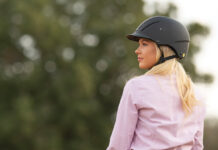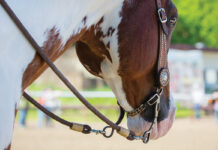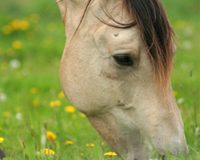Once you’ve made the decision to buy a horse, dust off your checkbook because you’re going to need it! Outfitting your new four-legged friend will make a dent in your pocketbook.
You can buy tack for your horse at a tack shop or order it from a catalog. You can shop on the Internet or at an equine expo. You can also buy used tack from horsey friends or at an auction. If you do buy used tack, check that it doesn’t have loose stitching which could break and cause an accident while you’re riding.
Talk to your riding instructor or to knowledgeable riders at the barn about what sort of tack you will need. There’s no point in investing in a dressage saddle if you just want to gallop over fences. Let’s take a look at some of the basic tack and equipment that you’ll need before your new horse arrives at the barn.
Halter and Lead Rope
A halter is a harness made of leather or nylon. It is worn on a horse’s head and it gives you control over the horse when he’s not being ridden. If you want your horse to wear a halter when he’s out in his field, buy a leather halter or a nylon halter with a breakaway leather headpiece. A horse can get hurt wearing a nylon halter out in a field if he gets caught on something.
Bridle
A bridle is worn on a horse’s head. It can be made of leather or a synthetic material such as nylon or Neoprene. They come in several sizes: pony, cob (a large pony or small horse), horse and extra large. Most bridles have hooks or buckles so you can adjust them to fit your horse perfectly.
Snaffle bits are used by western and English riders. The mouthpiece may be un-jointed (one piece) or jointed (two pieces joined in the middle.) The thinner the mouthpiece, the more severe the bit. If the mouthpiece is quite thick, you’ve probably chosen a mild bit. However, keep in mind that just because a bit is mild does not mean it is comfortable. If your horse has a small mouth, he may resent wearing an especially thick mouthpiece.
There are several types of snaffle bits that are popular, including:
- D-ring
- Full cheek
- Eggbutt
- Loose ring
If you ride western, you can use a simple snaffle bit or you may need a basic curb bit (sometimes called a shank bit). If you buy a curb bit, check to see if it comes with a curb chain.
Saddles
A saddle is the rider’s seat on a horse. It helps you to keep your balance so you don’t bounce around on your horse’s back and interfere with his natural movement. The type of saddle you buy depends on the type of riding you do. There are English saddles for jumping and dressage. There are western saddles for trail riding, roping and showing, to name a few.
Once you know what kind of saddle you need, start your search. It’s important to fit a saddle to the rider and the horse. Some tack shops have saddle fitters who can make sure that the saddle is comfortable for everyone. If the saddle doesn’t fit you, it can affect your balance and it can cause rubs on your legs. If it doesn’t fit the horse properly, it can pinch in places and make him misbehave.
If the store doesn’t have a saddle fitter, ask if you can take the saddle for a day or two and ask your instructor to watch you ride in it. Your instructor should be able to tell if the saddle fits the horse, too.
If you ride English, you may want to invest in a pair of safety stirrups—sometimes called peacock stirrups. These are made of stainless steel but one side of the stirrup is made from a heavy rubber band. If a rider falls and her foot gets caught in a normal stirrup, she could get dragged behind the horse and suffer a serious injury. If she falls off while using safety stirrups, her foot will snap the rubber band and there’s little risk of her being dragged. For western riders, look for stirrup designs that prevent a foot from becoming hung up. There are several manufacturers that have designed western safety stirrups.
Saddle Pads
A saddle pad goes under a saddle to keep the saddle clean and to protect the horse’s back. Saddle pads are made of cotton, wool, fleece, felt or foam. English saddle pads are usually square or saddle-shaped.
Western riders often use thick, rectangular blankets made of wool or cotton.
No matter what kind of pad you use, keep it clean by washing it regularly. A dirty pad can rub a horse and make him uncomfortable. Rinse dirty pads off with the hose on a daily basis and wash them in the washing machine with detergent once a week.
Girth or Cinch
An English girth or a western cinch is a belt that goes under a horse’s belly and keeps the saddle in place. English girths have two buckles at each end that attach to the saddle girth straps or billets. Western girths have big rings at each end, one of which usually has a buckle tongue.
Girths and cinches can be made of leather, cloth, wool, thick string or synthetic materials such as nylon or Neoprene.
Put a saddle on your new horse and measure the area where a girth or cinch would go so you can figure out what size to buy.
Equine Leg Wear
If your new horse is going to jump or gallop, invest in a set of splint boots for him. These are padded boots that fasten, usually with hook and loop designs, around a horse’s lower legs to protect his bones and muscles from getting knocked by his other legs while galloping or jumping. Splint boots are made of leather or a synthetic material. Synthetic splint boots are easiest because the boots just need to be hosed down if they get dirty or sweaty during a ride.
Blankets
If your horse lives in a chilly area, you may need to put a blanket on him sometimes. Here are the different kinds to consider buying:
Cooler: This is an extra-long fleece or wool blanket used on a hot, sweaty horse to absorb dampness and prevent him from becoming chilled.
Turnout blanket: Horses should be turned out in a field or paddock every day, if possible. If your new horse is clipped, he’ll need a turnout blanket in cold weather. Most turnout blankets are made of strong nylon that repels rain and acts as a windbreak.
Stable blanket: If your horse is clipped, he should wear a stable blanket in his stall at night in the winter.
It’s important to get the correct blanket size for your horse. Incorrectly fitted blankets can rub his skin and cause ugly sores that take forever to heal. To get the approximate blanket size, take a tape measure and measure him from the middle of his chest to the middle of his hindquarters.
Blankets need to be cleaned on a regular basis. Hose them off or toss them in the washing machine—if they fit.
Grooming Equipment
A tack shop will have a grooming kit box and all the gear you’ll need to fill it. Click here to see our Essential Grooming Supplies Checklist.
Lastly, before you bring home your new horse, invest in a first aid kit just for him. Horses always seem to be covered in lumps and bumps! You can buy ready-made first aid kits or you can pick up the items at a tack shop. Here’s what should be in a first-aid kit:
- Absorbent sheets of cotton and cotton balls
- Adhesive tape (duct tape will do!)
- Clean sponges
- Disinfectant or an antiseptic solution for cleaning wounds
- Epsom salts (for soaking hooves with sores or abscesses)
- Gauze roll and gauze squares
- Saline solution for flushing out wounds
- Scissors
- Several rolls of stretchy bandage
- A veterinary thermometer
- Wound spray, powder or gel
Buy a book on equine first aid and keep it in or near the first aid kit. It will be useful as a reference tool in case an emergency arises.
This article originally appeared in the 2008 edition of Horses USA. Click here to purchase the current edition.






Thank you for this very helpful article!
Very helpful!!! Thank you!
This article was very helpful. Thank You!!!!
helpful article